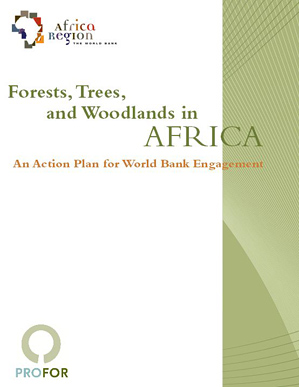
Share
Related Links
Attachments
Africa-Forests-Trees-ActionPlan_0_0.pdf
Keywords
Authors/Partners
World Bank Africa Region
Forests in Sub-Saharan Africa: Challenges & Opportunities
CHALLENGE
More than 70 percent of the population in Sub-Saharan Africa depends on forests and woodlands for its livelihood; one fifth of rural families’ daily needs come from forests. Woodlands and forests supply approximately 60 percent of all energy. Forest-related activities accounts for a large part of the GDP of most of the continent’s countries. And, Africa is home to 25 percent of the world’s remaining rainforests.
Despite significant international financial support to the forestry sector in the Sub-Saharan African countries, impacts on sustainable management and poverty alleviation are still below expectations.
APPROACH
PROFOR support to the World Bank’s Africa region sought to meet the need for a more comprehensive approach to tackling forest-related challenges and proposing solutions. This approach could help countries better incorporate forestry issues into overall development policy, identify priority actions, and help donors/partners who support development and forestry in Africa coordinate and finance programs more strategically.
PROFOR funding supported:
- A review of forestry documentation on Sub-Saharan Africa.
- Identification of challenges and issues in sub-regions, with an emphasis on obtaining lessons from past successes or failures.
- Identification of recommended options with an Action Plan; roles and responsibilities; partners and if possible indications of required financing.
- Coordination among development partners (multilateral and bilateral).
RESULTS
Findings from this activity were incorporated in Forest, trees, and woodlands in Africa : an action plan for World Bank engagement (June 2012). The report lays out 7 action areas, which involve policy measures, increased investments and a greater push for sound governance to better manage forests:
- Sustainable protection and development for wood-fuel and charcoal industries to serve domestic (and potentially export) markets;
- Landscape and watershed restoration, including planting trees and the development of policy measures to prevent future and mitigate past damages from mining investments;
- Plantation management to support a range of timber products in addition to wood-fuel including poles for construction and electricity transmission lines and furniture;
- Reforms and incentives in the domestic timber industry to reduce waste and support legal timber operators;
- Increased management planning, development, and financing for protected areas, community-based resource management and eco-tourism;
- Improved forest sales management in heavily forested countries
- Development of REDD+ (reduced emissions from deforestation and forest degradation) programs and carbon finance to help countries capture potential revenues from the carbon storing value of forests and promote co-benefits with communities through landscape restoration and reforestation projects.
Because of the geographic and climatic diversity in Africa, these action areas are adapted for the specific environmental challenges in each sub-region region (Sahel, humid West Africa, Central Africa, Eastern Africa, Southern Africa).
The report stresses that there is an urgent need to improve the availability and quality of information, especially statistical data, surrounding forests and woodlands. Mobile phones and other Information Communications and Technology are already being used to improve the collection and dissemination of forest data, including real-time fire alerts, game density mapping, and verification for legal timber operations.
For stories and updates on related activities, follow us on twitter and facebook , or subscribe to our mailing list for regular updates.
Author : World Bank Africa Region
Last Updated : 06-15-2024








